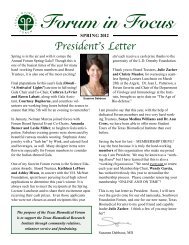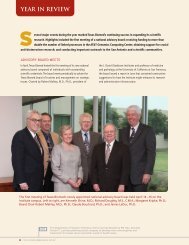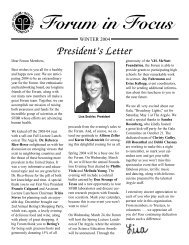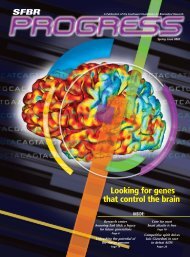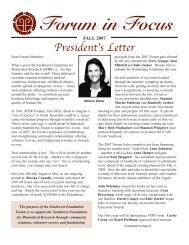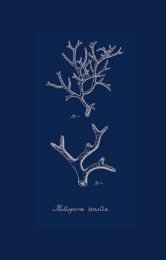Texas Biomed Science Report 2011-2012 - Texas Biomedical ...
Texas Biomed Science Report 2011-2012 - Texas Biomedical ...
Texas Biomed Science Report 2011-2012 - Texas Biomedical ...
Create successful ePaper yourself
Turn your PDF publications into a flip-book with our unique Google optimized e-Paper software.
Lorena M. Havill, Ph.D.<br />
Associate Scientist, Genetics<br />
Havill and her team investigate variation in risk of two common<br />
aging-related diseases of the skeletal system: osteoporosis (“fragile bone<br />
disease”) and osteoarthritis. These disorders are extremely common<br />
age-related skeletal diseases, but their causes, and, consequently,<br />
the ability to effectively prevent and treat them, remain elusive.<br />
Osteoporosis involves loss of bone from the skeleton and changes<br />
in the quality and arrangement of the remaining bone. The result<br />
is a skeleton that is more likely to fracture, especially at the hip,<br />
spine, and wrist. Osteoarthritis involves destruction of the joints of<br />
the skeleton, resulting in the pain, stiffness, and limited mobility<br />
that make this disease the leading cause of disability in the U.S.<br />
Havill and her team apply molecular and statistical genetic methods<br />
in studies of large extended pedigrees of baboons and humans to<br />
determine the degree to which genes and sex differences are responsible<br />
for variation in traits related to bone fragility and osteoarthritis<br />
pathogenesis. Havill studies not only traditional indicators of bone<br />
strength (such as bone density) but also more direct measures of<br />
bone’s resistance to fracture and of variation in joint biomechanics<br />
with engineers at the Southwest Research Institute (SwRI), using<br />
mechanical testing of bone and joint specimens using the baboon<br />
as a nonhuman primate model for human bone and joint health.<br />
Her research program is built on novel study designs to 1) reveal the<br />
fundamental biological mechanisms that underlie variation in risk of<br />
osteoporosis and osteoarthritis, and 2) identify the specific genes that are<br />
most important in disease risk. Her studies involve a holistic rather than<br />
reductionist approach to disorders of skeletal aging that she believes is<br />
<strong>2011</strong>–<strong>2012</strong> Scientific <strong>Report</strong><br />
“Osteoporosis and osteoarthritis are public health priorities of immediate concern because of the individual<br />
suffering and public health costs associated with these diseases, and because of the alarming rate at which<br />
their incidence is increasing as the population ages. My laboratory uses <strong>Texas</strong> <strong>Biomed</strong>’s baboon colony,<br />
ongoing family studies, and computing resources to identify the genes and biological processes that result in<br />
high risk of these diseases and that protect from age-related skeletal disorders.”<br />
Staff<br />
Left to right: Jennifer Harris, Heather Coan,<br />
Lorena Havill, Ahsan Choudary, Shayna Levine<br />
Publications<br />
• Havill LM, Mahaney MC, Binkley TL, Specker BL (2007) Effects of genes, sex, age, and<br />
activity on BMC, bone size, and areal and volumetric BMD. J Bone Miner Res 22:737-46.<br />
• Gourion-Arsiquaud S, Burket J, Havill LM, Dicarlo E, Doty S, Mendelsohn R, Ven Der Meulen<br />
M, Boskey A (2009) Spatial variation in osteonal bone properties relative to tissue and<br />
animal age. J Bone Miner Res 24:1271-81.<br />
• Hansen HL, Bredbenner TL, Nicolella DP, Mahaney MC, Havill LM (2009) Cross-sectional<br />
geometry of the femoral midshaft in baboons is heritable. Bone 45:892-7.<br />
• Havill LM, Bredbenner TL, Burr DB, Nicolella DP, Turner CH, Mahaney MC (2010) Heritability<br />
of lumbar trabecular bone mechanical properties in baboons. Bone 46:835-40.<br />
• Bredbenner TL, Eliason TD, Potter RS, Mason RL, Havill LM, Nicolella DP (2010) Statistical<br />
shape modeling describes variation in tibia and femur surface geometry between control<br />
and incidence groups from the Osteoarthritis Initiative Database. J Biomech 43:1780-6.<br />
essential to the significant advances in basic knowledge of these disease<br />
processes that are required for more effective prevention and treatment.<br />
She and her SwRI collaborator, Dan Nicolella, Ph.D., are developing<br />
a “bone structural integrity profile” with the goal of providing a<br />
new tool for assessing an individual’s risk of bone fracture, a risk<br />
that increases with age and the start of osteoporosis. She ultimately<br />
hopes to identify individuals who could benefit from early medical<br />
intervention to reduce their risk of fracture. In another project, she<br />
is studying osteoarthritis of the knee to gain much needed insight<br />
into the biological changes that occur in the very early stages of<br />
osteoarthritis, before significant joint destruction has occurred and<br />
when medical intervention is most likely to be effective. With the<br />
addition of postdoctoral fellow, Heather Coan, Ph.D., to her laboratory<br />
this past year, Havill is expanding her osteoarthritis research program<br />
to address the role of stem cells in osteoarthritis progression.<br />
E For more information, please visit www.txbiomed.org/departments/<br />
genetics/genetics-staff-bio?u=8<br />
17



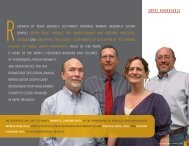
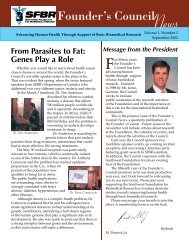
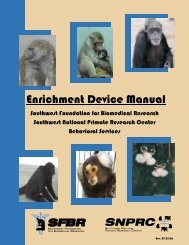
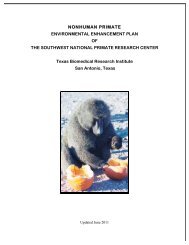
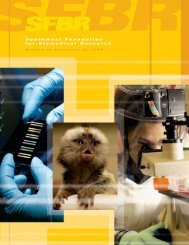
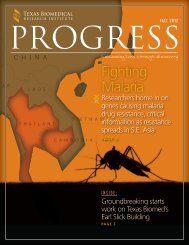
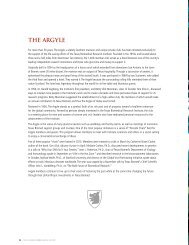
![Vol. 8 No. 2, 2011 [PDF] - Texas Biomedical Research Institute](https://img.yumpu.com/35688099/1/190x245/vol-8-no-2-2011-pdf-texas-biomedical-research-institute.jpg?quality=85)
